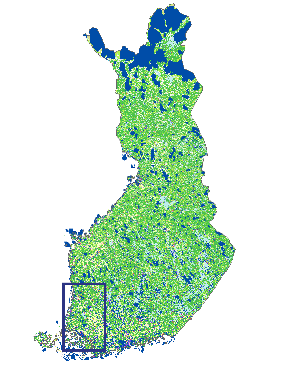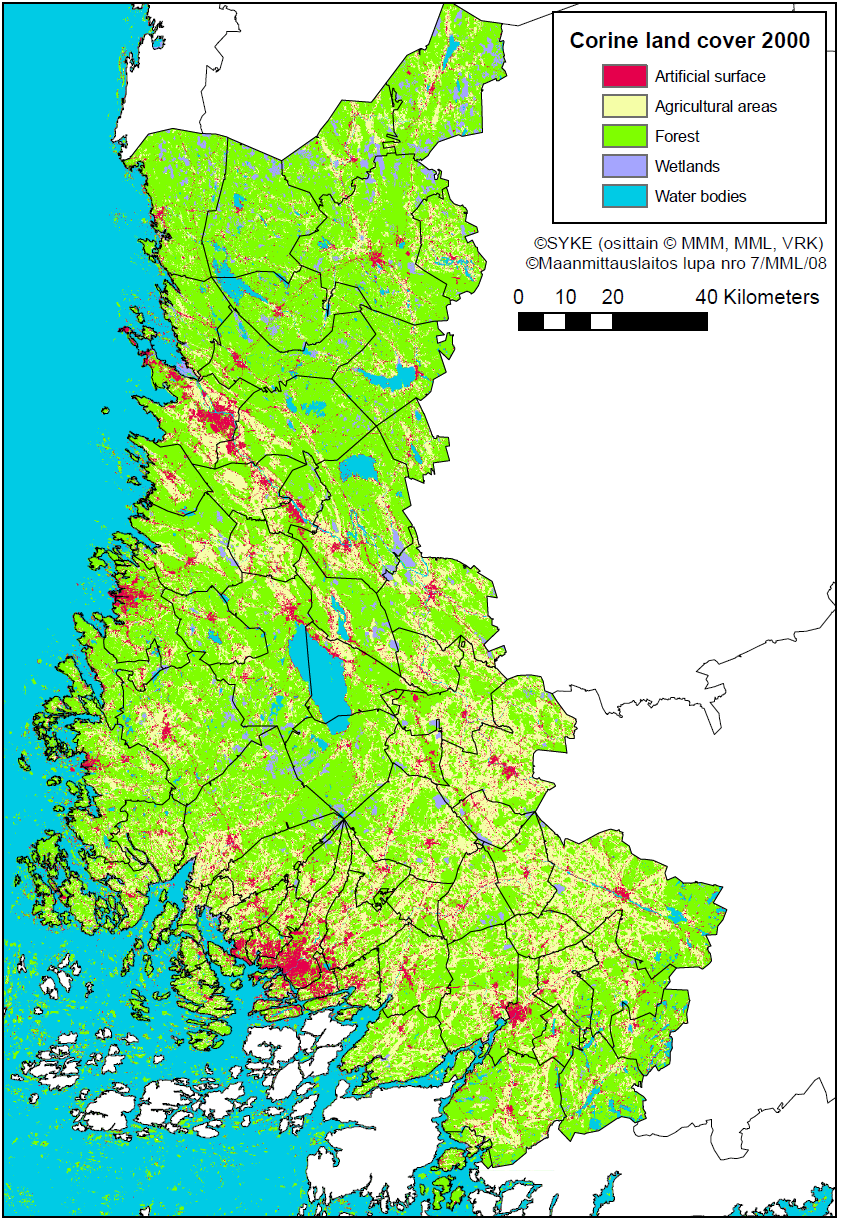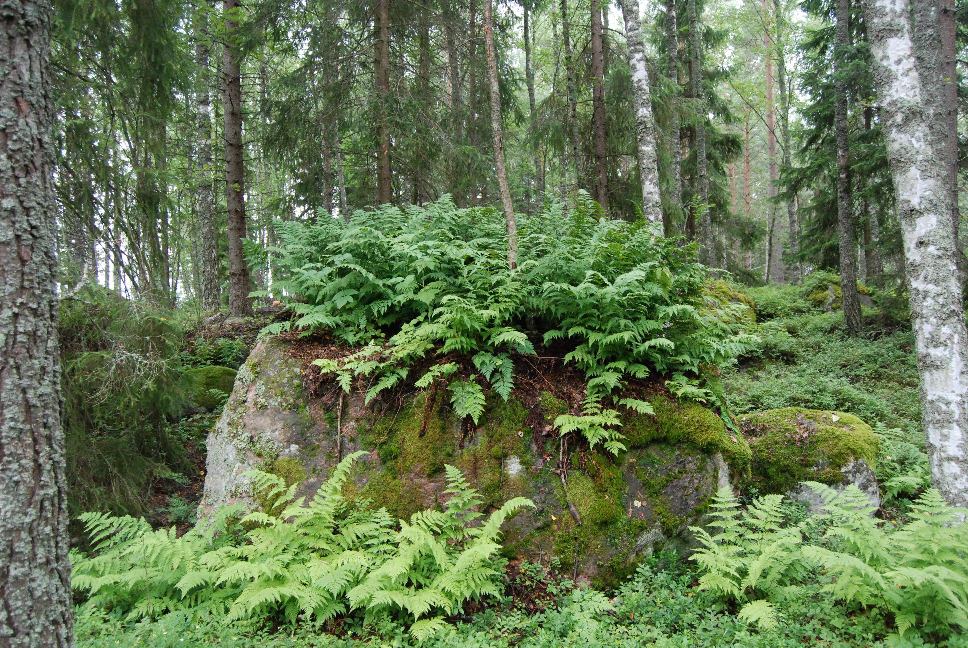Case study: Finland
Summary
This is a summary description of the coarse grain analysis of the Finnish Case study, and a brief description of the further research questions for the fine grain case study. Eeva Primmer, SYKE
Case study location and
conservation characteristics
Finland is a highly forested country, with at least two thirds of the
land covered with productive forests. Out of these 20 million hectares, two
thirds are owned by over half a million small-scale non-industrial private forest
owners. A great share of Finland's biodiversity and also endangered species
dwell in these commercially managed forests that concentrate in the southern
parts of the country. As only less than 2% of the forest land is preserved in
Southern Finland and centrally designed protection has generated severe
conflicts during the 1990s, the current approach to conservation is primarily
voluntary. The payments for ecosystem services (PES) under the Southern Finland
Forest Biodiversity Programme (METSO) currently form the core of the policy
instrument mix in Finnish forest biodiversity conservation. The Finnish case
study outlines the status of biodiversity and the policy instrument mix for
biodiversity conservation at the national level in a coarse grain fashion. Further
in the project, voluntary contracting and the impacts of the instrument mix
will be analyzed in South-Western Finland.
Current economic
instruments in biodiversity conservation
 Currently, the formal Finnish forest
biodiversity conservation instruments include regulatory instruments and
economic instruments as well as information and extension services. The traditional
national parks, strict nature reserves and nature conservation programme areas
(including the European Union Natura 2000) are supplemented with Forest Act
habitats and Forested Nature Conservation Act habitats. Private protected areas
are currently established dominantly through positive economic incentives under
the METSO Programme attracting voluntary offers from forest owners, in a PES
fashion. This protected area contracting is the responsibility of the
environmental administration. Under the METSO Programme, PES contracts are also
made for a fixed term by the forestry administration, under the Act for
Financing Sustainable Forestry. The two PES-like mechanisms merge the ideas and
practices of the PES contracts piloted jointly by the environmental and forestry
administration in 2002-2007 and the pre-existing environmental subsidy that
compensates for timber income loss.
Currently, the formal Finnish forest
biodiversity conservation instruments include regulatory instruments and
economic instruments as well as information and extension services. The traditional
national parks, strict nature reserves and nature conservation programme areas
(including the European Union Natura 2000) are supplemented with Forest Act
habitats and Forested Nature Conservation Act habitats. Private protected areas
are currently established dominantly through positive economic incentives under
the METSO Programme attracting voluntary offers from forest owners, in a PES
fashion. This protected area contracting is the responsibility of the
environmental administration. Under the METSO Programme, PES contracts are also
made for a fixed term by the forestry administration, under the Act for
Financing Sustainable Forestry. The two PES-like mechanisms merge the ideas and
practices of the PES contracts piloted jointly by the environmental and forestry
administration in 2002-2007 and the pre-existing environmental subsidy that
compensates for timber income loss.
New and potential economic
instruments
To
scope for new potential conservation instruments, the Finnish case study has
ran a focus group workshop with the Advisory Board members, representing
environmental and forestry administration, land-use planning, forest owners and
environmental NGOs of national level and local level. The already upcoming new
instruments or changes in existing instruments identified in the focus group
included broadening law-based habitat conservation to cover more habitat types,
or providing significantly more subsidies or incentives for nature management
and restoration of altered habitats or diversifying forest management and
silviculture with uneven-aged forest management. More radical new instruments
identified by the focus group include strengthening
nature conservation by developing a biodiversity law, allocating more nature
conservation power and budgetary resources to environmental administration, or backing
up the environmental administration with more forest nature management
competencies to allow forest administration to focus mostly on forestry.
Also developing economic instruments by increasing incentives significantly and
paying for existing or increased nature values or developing land-use planning
would be more radical developments.
Instrument interactions in
the national policymix
The
different policy instruments in the current mix supplement each other in
potentially attracting different types of forest-owners; more preservation
oriented owners will choose a permanent private protected area and more
forestry income oriented ones will choose the fixed-term METSO-PES. According
to the Case Study Advisory Board members, fixed-term contracts have functioned
as a gateway for forest-owners to enter a conservation contract, attracting
them to consider also permanent conservation. This proposition will be examined
further in the fine grain analyses. It is also possible that conservation
programmes preceding the METSO era provide motivation for taking up less
restrictive instruments. This potential 'regulatory assurance', where the
existence of a regulatory instrument is crucial for the success of a voluntary
instrument, will be further studied.
The
sequence of the policy instruments has clearly played an important role in the
evolution of the Finnish METSO PES. Without the criticism against the
conservation programmes and the implementation of the Natura 2000 network, the
METSO incentives would not have been developed. Similarly, the success of the
PES has largely relied on the new opportunities and new practices brought by
the voluntary scheme implemented in collaboration between the environmental and
forestry administrations, although the piloted joint administration has
discontinued. As our analysis of the institutional evolution demonstrates, the
current application of the METSO-PES has reverted back to many institutional
features that existed prior to the METSO pilot. Further analysis will
rigorously test the prevalence of the different institutional factors that
influence contract uptake currently and also examine how different institutional
arrangements characterize the potential outcomes of future policy-mixes.
Local fine grain
analysis – research questions and challenges
Fine grain case study site
description
 South-Western
Finland is densely populated and has a diverse economy for the generally very
rural Finland. The area has 1 million hectares forest land, out of which
private people own 80%. These 37 000 non-industrial private forest holdings are
generally small in size, averaging at 21 hectares. Compared to the rest of the
country, forest owners in the area have acquired ownership actively and only a
third has inherited the land. Typical of southern Finland, the forests in the
area are fertile, productive and intensively managed. The same forests are used
for recreation, berry and mushroom picking and hunting.
South-Western
Finland is densely populated and has a diverse economy for the generally very
rural Finland. The area has 1 million hectares forest land, out of which
private people own 80%. These 37 000 non-industrial private forest holdings are
generally small in size, averaging at 21 hectares. Compared to the rest of the
country, forest owners in the area have acquired ownership actively and only a
third has inherited the land. Typical of southern Finland, the forests in the
area are fertile, productive and intensively managed. The same forests are used
for recreation, berry and mushroom picking and hunting.
The area has low
conservation coverage, with 2,5 percent of the forest area strictly protected
and 0,4 percent of private forests designated as Forest Act habitats. The South-Western
Finland Forestry Centre region piloted the METSO Programme during 2003-2007.
Actually, the so-called ‘nature values trading’ PES instrument idea originates
in the area. As the forest owners in the area are have been exposed to the
voluntary policy instruments for a ten-year period already and the
administration has been engaged in developing these instruments, South-Western
Finland makes an ideal case study area.
Economic instrument effectiveness
The ecological outcome of voluntary conservation
payments and of instrument mixes should be evaluated against the conservation
challenges that include low coverage and connectivity of protected areas. The
case study will layer the METSO PES forest holdings on a general Zonation
output to evaluate the conservation effectiveness in the fine grain analysis.
Additionally, to allow scenario analysis, the structure and the
quality of the forests that were included in the METSO PES holdings will be
examined with spatial analysis of forest inventory data. The structure and the
quality of the forests will be assessed with forest site types, dominant tree
species, development classes, age classes, volume of the growing stock and
increment of growing stock. These spatial analyses will be combined with
spatially referenced views of forest owners regarding the ecosystem services
that their forests provide from the survey responses.
Economic instrument costs and benefits
For understanding the costs and
benefits of conservation instruments, it is essential to understand the
difference that the PES contract or instrument mix makes as compared to no
conservation effort. Generally, opportunity costs are an important starting
point when analysing the conservation of previously commercially managed
forests. In addition to the opportunity costs, also the forest-owner views on
what rights they give up generate an important cost factor. As regards the
benefits, it is essential to acknowledge the ecosystem services that the forest
owners identify their contracted sites to provide, as they are well aware of
the functions of their forests and those who have already made a contract, have
first-hand experience with both benefits and costs. The Finnish local level
case study will evaluate the factors that have contributed to contracting and the
payment request of contracted and non-contracted forest owners, as well as
their perceptions of multiple benefits of conservation. The real contract fees
will be used to validate the payment request.
The Finnish fine grain analysis will
advance the understanding of contractual, institutional and social factors
contributing to the payment request. Similarly, the fine grain analysis will
allow measuring the value that the forest-owners place on the ecosystem
services they provide by contracting. As the contracts are voluntary, and they
are a genuine opportunity for any forest-owner who has an eligible site on
their land, the payment request reflects the ecosystem service value of the
service provider in a realistic fashion. Plotting the significant impacting
factors on a map, the fine-grain analysis will also explore the possibilities of
GIS analysis of timber-sale value (opportunity cost) on willingness to contract
and payment request levels. Similarly, transaction costs can be evaluated both
with the results of the survey (time invested in contracting and negotiation
time) and GIS analysis (distance to agency).
Economic instrument equity
and legitimacy
 Finnish forest-owners are relatively
wealthy and often rather independent from regular forestry income, and the
forest sector is rather powerful in steering timber production and also
influencing forest biodiversity policy. With the conflictuous history, the
administration seeks to treat forest-owners as equally and equitably as
possible. The private benefits of conservation and PES experienced by
forest-owners are often simplified to be expressed by income changes but they
can be much broader. Benefits experienced by forest owners include perceived
changes in benefit distribution, equal opportunity to contract and use multiple
ecosystem services, autonomy to decide about conservation and forest use,
justness of rights and responsibilities, security and predictability of the
policy and contract terms, and finally, biodiversity and ecosystem benefits.
The Finnish local level case study will address both distributive impacts and
legitimacy directly with the forest-owner survey.
Finnish forest-owners are relatively
wealthy and often rather independent from regular forestry income, and the
forest sector is rather powerful in steering timber production and also
influencing forest biodiversity policy. With the conflictuous history, the
administration seeks to treat forest-owners as equally and equitably as
possible. The private benefits of conservation and PES experienced by
forest-owners are often simplified to be expressed by income changes but they
can be much broader. Benefits experienced by forest owners include perceived
changes in benefit distribution, equal opportunity to contract and use multiple
ecosystem services, autonomy to decide about conservation and forest use,
justness of rights and responsibilities, security and predictability of the
policy and contract terms, and finally, biodiversity and ecosystem benefits.
The Finnish local level case study will address both distributive impacts and
legitimacy directly with the forest-owner survey.
The analysis will focus on perceived
benefits and their contribution to contracting. The Finnish case study will
contribute to the debate about fairness and equity in PES with experiences from
a wealthy empirical context. With the forest-owner views on ecosystem service
benefits and their relation to payment request, the survey will also allow
discussing the generally held views that values placed on ecosystem services
are of a public character and that their valuation should rely on contingent valuation
methods. The Finnish forest-owner survey will address the forest owners' use of
information, their trust and their shared interests relative to a range of
relevant actors implementing and intermediating the METSO PES.
Institutional
opportunities and constraints for economic instruments
Introducing PES instruments will
necessarily change forest owners’ rights and responsibilities. By doing this, the
PES re-determine also the rights and responsibilities of different
administrative and organizational actors. In addition to these formal
regulative institutions, changes occur in the normative institutions carried by
professional and standardized practices as well as cultural cognitive
institutions reflecting the perceived functions of forests, forest management
and biodiversity conservation. Although the PES contract terms and their acceptability
have been studied in Finland, and the role of the administration and
intermediaries is also well known, the forest-owners' views on their own rights
and responsibilities has not been analyzed together with their views of the
rights and responsibilities of other actors. The Finnish fine grain analysis
will close this knowledge gap.
Much of the Finnish local level case study focuses on
the rights and responsibilities and the impacts of their redistribution,
through forest-owner perceptions. In addition to analysing the influence of
institutions on the take up of a PES contract and the payment request, the
survey will allow in-depth analysis of the weight placed on the rights of
different actors, which can be analyzed against earlier work on legitimacy and institutions
of forest biodiversity governance. The results will enlighten the institutional options and
constraints of METSO PES and other instruments. This will be backed up by the focus group work for the multicriteria analysis of instrument mix scenarios.
Integrated policymix
assessments
Environmental decisions and policy
assessments are often complex, involve many different stakeholders and
typically draw on multidisciplinary knowledge bases, incorporating natural,
physical and social sciences, politics and ethics. To consider the multiple
impacts and constraints of different instruments applied jointly, the Finnish
case study will conduct a spatially referenced multi-criteria analysis (MCA) of
instrument-mix scenarios. This will not be a full blown spatial MCA, but the
method relies on combined use of geographic information systems (GIS), spatial
analyses and MCA.
 The GIS is used to
produce and handle the geo-referenced data needed for producing the alternative
conservation area configurations under the different instrument mix scenarios,
and as a platform to present and visualise the results of the analyses as
thematic maps. The MCA will draw from the fine-grain analysis of institutional,
social, ecological and economic perceptions of forest owners. The scenarios
will take the existing budget as a starting point and take the current
implementation of METSO PES as baseline scenario. Based on stakeholder focus group
work, the alternative scenarios will be built around the following new
instrument mixes 1) Voluntary permanent conservation; 2) Enforced spatially
concentrated permanent conservation, 3) Voluntary permanent conservation with
active nature management; 4) Voluntary temporary conservation. The ecological
indicators considered for this analysis include carbon sequestration, forest
age structure and its changes, the amount of fertile forest site types,
connectivity and the amount of coarse woody debris. The economic indicators
considered include opportunity costs (lost timber sales income), transaction
costs (negotiation time) and employment opportunities. The social indicators
considered include recreational opportunities, perceptions on who benefits and
distribution of benefits in society, perception of legitimacy and fairness of
the contracting process. The information for the indicators will be obtained
from the administration, the forest owner survey, forest resource information
and from the Streering Group of the Finnish case study. The Streering Group
will represent the decision maker in the MCA and state preferences for the
different criteria and indicators.
The GIS is used to
produce and handle the geo-referenced data needed for producing the alternative
conservation area configurations under the different instrument mix scenarios,
and as a platform to present and visualise the results of the analyses as
thematic maps. The MCA will draw from the fine-grain analysis of institutional,
social, ecological and economic perceptions of forest owners. The scenarios
will take the existing budget as a starting point and take the current
implementation of METSO PES as baseline scenario. Based on stakeholder focus group
work, the alternative scenarios will be built around the following new
instrument mixes 1) Voluntary permanent conservation; 2) Enforced spatially
concentrated permanent conservation, 3) Voluntary permanent conservation with
active nature management; 4) Voluntary temporary conservation. The ecological
indicators considered for this analysis include carbon sequestration, forest
age structure and its changes, the amount of fertile forest site types,
connectivity and the amount of coarse woody debris. The economic indicators
considered include opportunity costs (lost timber sales income), transaction
costs (negotiation time) and employment opportunities. The social indicators
considered include recreational opportunities, perceptions on who benefits and
distribution of benefits in society, perception of legitimacy and fairness of
the contracting process. The information for the indicators will be obtained
from the administration, the forest owner survey, forest resource information
and from the Streering Group of the Finnish case study. The Streering Group
will represent the decision maker in the MCA and state preferences for the
different criteria and indicators.